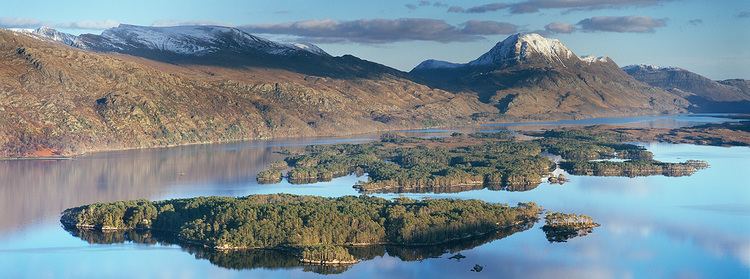Basin countries United Kingdom Max. width 4 km (2.5 mi) Average depth 125 ft (38 m) Area 28.6 km² Width 4 km | Max. length 20 km (12 mi) Surface area 28.6 km (11.0 sq mi) Length 20 km Mean depth 38 m | |
 | ||
Catchment areas | ||
Scotland road trip loch maree and assynt
Loch Maree (Scottish Gaelic: Loch Ma-ruibhe) is a loch in Wester Ross in the Northwest Highlands of Scotland. At 20 km (12 mi) long and with a maximum width of 4 km (2.5 mi), it is the fourth largest freshwater loch in Scotland; it is the largest north of Loch Ness. Its surface area is 28.6 km2 (11.0 sq mi).
Contents
- Scotland road trip loch maree and assynt
- Map of Loch Maree Achnasheen UK
- TourismEdit
- EcologyEdit
- MountainsEdit
- In mediaEdit
- References
Map of Loch Maree, Achnasheen, UK
Loch Maree contains five large wooded islands and over 60 smaller ones, many of which have their own lakelets. Isle Maree has the remains of a chapel, graveyard, holy well, and holy tree on it, believed to be the 8th century hermitage of Saint Máel Ruba (d. 722), who founded the monastery of Applecross in 672. The same island contains ancient stands of oak and holly which have been linked with ancient Scottish druids.
The waters of the loch were also thought to have curative effects, with being submerged in the water thought to be a cure for lunacy. All of the loch's islands are conservation areas. The largest is the only island in Britain to contain a loch that itself contains an island. Like Loch Ness, Loch Maree has its own monster in the form of the muc-sheilch. The loch is often referred to as the most beautiful loch in the Highlands.
TourismEdit
Due to its remote location there is little industry and tourism surrounding Loch Maree. Early on, it became a popular spot for trout fishing after Queen Victoria visited the Loch Maree Hotel at Talladale in 1877, a visit which led to the naming of Victoria Falls, an attractive waterfall feeding the loch from Beinn Eighe on its south side.
EcologyEdit
Loch Maree is of international importance for its special wildlife and biodiversity. Until recently, thousands of adult sea trout (seagoing brown trout Salmo trutta) and salmon (Salmo salar) returned to the loch from the sea every summer. Sea trout gathered in huge numbers in certain bays, providing some of the most exciting angling in Scotland for which the loch had an international reputation. A British record sea trout of 19.5 lb was caught on a "dapping fly" in the loch in 1952. The sea trout fishery collapsed in the 1980s and 1990s.
Sea trout and salmon are an important part of Loch Maree's ecosystem providing food for black-throated diver and otter (Lutra lutra) for which the loch is a designated Special Area of Conservation and Special Protected Area under the EU Habitats Directive. Juvenile trout can be an important part of the diet of black-throated diver. The loch also has two separate populations of Arctic charr (Salvelinus alpinus) about which little is known. One form of charr, with a big eye which feeds on the bottom in deep water matures at less than 15 cm. The other form grows to over 32 cm and can sometimes be seen in shoals ruffling the surface when the loch is calm.
Loch Maree was designated a Ramsar site on 19 September 1994. The area hosts the golden eagle.
MountainsEdit
The loch is bounded to the east by Slioch, a mountain over 3000 feet high, and which dominates its surroundings. It is composed mainly of Torridonian sandstone of Precambrian age. It is a popular for hill walking, scrambling and climbing. The main peak to the west is Beinn Eighe, a Torridonian mountain capped with quartzite.
In mediaEdit
Button-box accordionist, Fergie MacDonald topped the Scottish pop charts in 1966 with the tune "Loch Maree Islands" which pays tribute to the views of the Loch, and vocal versions have been recorded by many artists over the years, notably Calum Kennedy.
In the 2009-10 series of the BBC's Natural World, episode 6, Highland Haven, stayed closer to home than usual, with a year-long look at the environment and wildlife of the UK's oldest National Nature Reserve, Beinn Eighe, along the southern shores of Loch Maree.
Loch Maree is mentioned in the Runrig song "The Summer Walkers" from the album "The Stamping Ground"
And it's up by the ShinAnd up by the 'NaverAnd the long winding shores Of Loch MareeBy Ben Hope and Ben LoyalStack and by ArkleThe road reaches farNow the summer is here